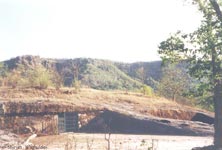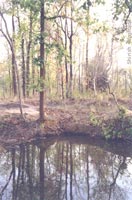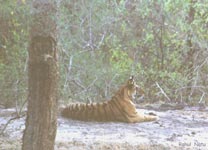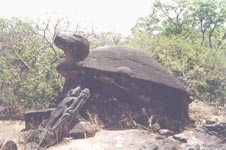
As our jeep climbed up from the Badi Goofa, a herd of Chital grazing
around scampered across the road. But this time it was not due to
the mere disturbance caused by a tourist vehicle. Once across the
road, every one of them was gazing intently towards a particular area
and some of them started giving the bark-like alarm call and stamping
the ground with their frontfoot. Our presence didn't seem to matter
at all. A lone male, who had not crossed the road, and who appeared
to be the leader of the herd, also started to stamp the ground and
giving the alarm call. A sure indication of a predator in the
vicinity.
 Our guide then spotted some movement on the hillock. And sure enough
we spotted a Chital lying down with a Leopard on top of it, holding
the Chital by the throat. The Chital was still struggling, kicking
around every now and then and trying to throw off the big cat. The
Leopard must have felled it just a few moments ago. After a struggle
which lasted nearly 4-5 minutes, the Chital lay still and the Leopard
let go its throat and sat erect. All was quiet. The alarm calls had
stopped and the other Chital went about their business of grazing.
All through, the Leopard always managed to stay on the side away from
the kicking feet of the Chital. Tired from the hunt, it rested a
while near the kill and then walked away some 8-10 m or so and sat on
a rock affording us a great view. Though we were watching it for
more than 15 minutes, we just didn't seem to get enough of the
Leopard. But it was getting near closing time of the park and we had
to leave.
Our guide then spotted some movement on the hillock. And sure enough
we spotted a Chital lying down with a Leopard on top of it, holding
the Chital by the throat. The Chital was still struggling, kicking
around every now and then and trying to throw off the big cat. The
Leopard must have felled it just a few moments ago. After a struggle
which lasted nearly 4-5 minutes, the Chital lay still and the Leopard
let go its throat and sat erect. All was quiet. The alarm calls had
stopped and the other Chital went about their business of grazing.
All through, the Leopard always managed to stay on the side away from
the kicking feet of the Chital. Tired from the hunt, it rested a
while near the kill and then walked away some 8-10 m or so and sat on
a rock affording us a great view. Though we were watching it for
more than 15 minutes, we just didn't seem to get enough of the
Leopard. But it was getting near closing time of the park and we had
to leave.
This once-in-a-lifetime sighting was a fantastic bonus during our field trip to the Bandhavgarh National Park.
 The Bandhavgarh National Park derives its name from the Bandhavgarh
fort situated inside the park. Bandhavgarh means brother's fort -
the fort is supposed to have been a gift by Rama to his brother
Laxman while they were returning from Lanka. The fort and the
surrounding forests belonged to the erstwhile maharaja of Rewa.
Being their private game reserve, the maharajas ensured adequate
protection to the forests and its denizens. The abundance of game
can be gauged from the stone plaque in the forest which marks the
place where the maharaja had killed his hundredth Tiger! After
independence the Government of India took over the forests but the
ex-maharaja of Rewa held on to the fort and his descendants claim
that it is their private property. The park covers an area of nearly
1160 sq.km. and has been declared a Tiger Reserve under Project
Tiger.
The Bandhavgarh National Park derives its name from the Bandhavgarh
fort situated inside the park. Bandhavgarh means brother's fort -
the fort is supposed to have been a gift by Rama to his brother
Laxman while they were returning from Lanka. The fort and the
surrounding forests belonged to the erstwhile maharaja of Rewa.
Being their private game reserve, the maharajas ensured adequate
protection to the forests and its denizens. The abundance of game
can be gauged from the stone plaque in the forest which marks the
place where the maharaja had killed his hundredth Tiger! After
independence the Government of India took over the forests but the
ex-maharaja of Rewa held on to the fort and his descendants claim
that it is their private property. The park covers an area of nearly
1160 sq.km. and has been declared a Tiger Reserve under Project
Tiger.
Bandhavgarh is situated in the Vindhya Hills of the Shahdol district of Madhya Pradesh. Tourists are allowed to enter the park only from Tala, a village on the Northeastern boundary of the Park. Katni, 92 km from Tala, on the Jabalpur-Banaras line is the convenient railhead, though Umaria, 32 km from Tala, on the Katni-Bilaspur line is the nearest station. Private buses and jeep taxis are available from both Katni and Umaria to reach Tala. Private boarding and lodging facilities to suit every budget are available in Tala. The forest department also has a small rest house but getting a booking in it is difficult.
Visitors are allowed inside the park for two hours after sunrise and two hours before sunset. Private jeeps for moving inside the park, which charge Rs.500/- per ride, can be engaged in Tala. Movement on foot inside the park is prohibited. Alternately, one can book the elephants of the forest department at Rs.60/- per person per hour. Taking a guide along is also mandatory. The forest personnel scout the park and keep a track of the movement of Tigers which is communicated over the wireless network and so the chances of sighting a Tiger are quite high.
 The park contains hilly regions, undulating forests as well as
grasslands thus providing a rich habitat for a variety of flora and
fauna. The good forest cover and the predominant sandstone rock soak
in rainwater and then release it slowly so that there are as many as
four perennial streams in the park and even at the peak of summer,
water can be found in most of the small ponds and waterholes.
The park contains hilly regions, undulating forests as well as
grasslands thus providing a rich habitat for a variety of flora and
fauna. The good forest cover and the predominant sandstone rock soak
in rainwater and then release it slowly so that there are as many as
four perennial streams in the park and even at the peak of summer,
water can be found in most of the small ponds and waterholes.
 The area is rich in mammals as well as birds. During our trips
inside the park, we could easily sight herds of
Chital
and
Sambar,
packs of
Black-faced Langur,
and sounders of
Wild Boar.
We also
spotted
Jackals
and
Foxes
and a couple of
Barking Deer
and
Nilgai.
Droppings of the
Sloth Bear
and
Hyenas
in many areas of the park
indicated their presence but we were not lucky enough to see either.
Common Peafowl, Red Jungle Fowl, Blossomheaded Parakeet, Redvented
Bulbul, Whitebreasted Kingfisher, Goldenbacked Woodpecker, Green
Pigeons, Jungle Babbler, Whitebacked Vulture, Indian Roller,
and
Green Bee-eater
were some of the commonly seen birds. Notable were the
Crested
Serpent Eagle, Storkbilled Kingfisher, Yellowfronted Pied Woodpecker,
Adjutant Stork,
and the
Malabar Pied Hornbill.
The area is rich in mammals as well as birds. During our trips
inside the park, we could easily sight herds of
Chital
and
Sambar,
packs of
Black-faced Langur,
and sounders of
Wild Boar.
We also
spotted
Jackals
and
Foxes
and a couple of
Barking Deer
and
Nilgai.
Droppings of the
Sloth Bear
and
Hyenas
in many areas of the park
indicated their presence but we were not lucky enough to see either.
Common Peafowl, Red Jungle Fowl, Blossomheaded Parakeet, Redvented
Bulbul, Whitebreasted Kingfisher, Goldenbacked Woodpecker, Green
Pigeons, Jungle Babbler, Whitebacked Vulture, Indian Roller,
and
Green Bee-eater
were some of the commonly seen birds. Notable were the
Crested
Serpent Eagle, Storkbilled Kingfisher, Yellowfronted Pied Woodpecker,
Adjutant Stork,
and the
Malabar Pied Hornbill.
 On the second morning of our stay in the park, a Tigress with two
cubs was reported to have been sighted in the Chakradhara grassland,
just a few kilometers from the main gate and we headed that way. The
Tigers were in the grasses and we could not see them from the road.
7-8 jeeps had already converged at that point and we had to await our
turn for getting on to an elephant and go into the grasses to take a
close look at the big cats. They were so well camouflaged that an
untrained eye would easily overlook their presence there. The
elephants moved as close as 8-10 m from the Tigers. The Tigress was
resting and the cubs generally playing around. It was an exciting
and exhilarating sight. We were told that the cubs were 8-9 months
old. They seemed oblivious to the elephants and their riders. But
as word spread, more and more tourists landed up and the Tigress
decided that it was time to move. The elephants followed them till
they crossed the road and moved on towards the hills. Some 8-10
jeeps were waiting on the road to watch them leaving very little room
for the Tigers to pass and the cubs seemed a bit alarmed and hesitant
to cross the road.
On the second morning of our stay in the park, a Tigress with two
cubs was reported to have been sighted in the Chakradhara grassland,
just a few kilometers from the main gate and we headed that way. The
Tigers were in the grasses and we could not see them from the road.
7-8 jeeps had already converged at that point and we had to await our
turn for getting on to an elephant and go into the grasses to take a
close look at the big cats. They were so well camouflaged that an
untrained eye would easily overlook their presence there. The
elephants moved as close as 8-10 m from the Tigers. The Tigress was
resting and the cubs generally playing around. It was an exciting
and exhilarating sight. We were told that the cubs were 8-9 months
old. They seemed oblivious to the elephants and their riders. But
as word spread, more and more tourists landed up and the Tigress
decided that it was time to move. The elephants followed them till
they crossed the road and moved on towards the hills. Some 8-10
jeeps were waiting on the road to watch them leaving very little room
for the Tigers to pass and the cubs seemed a bit alarmed and hesitant
to cross the road.
 Though the probability of sighting a Tiger in Bandhavgarh is quite
high, it's always a matter of chance - a minute here or there makes a
lot of difference and our sighting of the Leopard and that of another
Tigress and her two cubs drove home the point very strongly.
Though the probability of sighting a Tiger in Bandhavgarh is quite
high, it's always a matter of chance - a minute here or there makes a
lot of difference and our sighting of the Leopard and that of another
Tigress and her two cubs drove home the point very strongly.
A misunderstanding with the jeep driver actually helped us spot the other Tigress with two cubs at Ghodademon. The Tigress with its cubs was sighted in the morning in that area. In the evening, we asked our driver to take us to the same area. But somehow he thought that we wanted to go in the opposite direction and took us towards Mehman Pond. On realising the error, we retraced our path and moved towards Ghodademon. It was getting late and we crossed jeeps which were returning from Ghodademon disappointed that the Tigers did not come out in the open. We carried on all the same and just as we reached Ghodademon, the Tigress decided to make an appearance and moved out of the bushes and crossed over an exposed hillock to disappear into a depression below. We were also lucky to see its two cubs moving around some distance away. The cubs seemed more like fully grown Tigers and we were told that they were nearly two years old and might leave their mother's side soon. If we had directly come there without taking the detour, we might have left with the other jeeps and missed the Tigress and her cubs.
 Stretching our luck further, we moved down the road to see if we
could sight the Tigress again. To our great joy, as we turned a
bend, we saw the Tigress climbing up from the depression. She came up
and casually sat on a rock about 10 m from the road giving us an
unobstructed view. There she sat preening herself, ignoring us
completely. She did not even bother to turn her head as our driver
opened and shut the door of the jeep making quite some noise. But
then a Sambar gave out an alarm call and instantly the Tigress turned
her head in that direction. Most probably she wasn't in search of a
prey and apart from generally scanning the area, she did not stir and
went back to her preening. We watched her for nearly 15 minutes and
then had to reluctantly leave to make it to the main gate in time.
Stretching our luck further, we moved down the road to see if we
could sight the Tigress again. To our great joy, as we turned a
bend, we saw the Tigress climbing up from the depression. She came up
and casually sat on a rock about 10 m from the road giving us an
unobstructed view. There she sat preening herself, ignoring us
completely. She did not even bother to turn her head as our driver
opened and shut the door of the jeep making quite some noise. But
then a Sambar gave out an alarm call and instantly the Tigress turned
her head in that direction. Most probably she wasn't in search of a
prey and apart from generally scanning the area, she did not stir and
went back to her preening. We watched her for nearly 15 minutes and
then had to reluctantly leave to make it to the main gate in time.
 We trekked up the fort one day. One has to take special permission
to enter the fort, pay a separate fee and take a guide along as well.
The climb begins from Shesh Shaiya - a stone idol of Vishnu reclining
on the serpent Shesh. Due to the heat, the going was slow and it
took us nearly an hour to reach the temple at the top of the fort.
All along the way to the top of the fort are stone idols of Vishnu in
his various incarnations. There are a number of caves with
inscriptions and pictures which are said to belong to the Mauryan
period. The temple is quite picturesque and is devoted to Ram,
Laxman, and Sita. An old pujari is the only person staying there and
claims not to have gone down in the last 32 years!
We trekked up the fort one day. One has to take special permission
to enter the fort, pay a separate fee and take a guide along as well.
The climb begins from Shesh Shaiya - a stone idol of Vishnu reclining
on the serpent Shesh. Due to the heat, the going was slow and it
took us nearly an hour to reach the temple at the top of the fort.
All along the way to the top of the fort are stone idols of Vishnu in
his various incarnations. There are a number of caves with
inscriptions and pictures which are said to belong to the Mauryan
period. The temple is quite picturesque and is devoted to Ram,
Laxman, and Sita. An old pujari is the only person staying there and
claims not to have gone down in the last 32 years!
 Besides the lake near the temple, there are two small lakes on the
fort. These attract a lot of wildlife including Tigers. The Raja ka
Machaa is a stone seat on one of the outcrops of the fort and one can
get a beautiful view of the forests below from this point. The guide
claimed that from that point, during winter, Tigers can be seen
moving around in the forests below. We saw Tiger pugmarks and
droppings on the fort as well. The fort also has a good birdlife and
we saw half a dozen Malabar Pied Hornbills on a single tree. On the
cliffs of the fort we could spot a couple of nests of the Longbilled
Vulture with juveniles in it. We spent the day on the fort and
climbed down in time for the evening jeep ride.
Besides the lake near the temple, there are two small lakes on the
fort. These attract a lot of wildlife including Tigers. The Raja ka
Machaa is a stone seat on one of the outcrops of the fort and one can
get a beautiful view of the forests below from this point. The guide
claimed that from that point, during winter, Tigers can be seen
moving around in the forests below. We saw Tiger pugmarks and
droppings on the fort as well. The fort also has a good birdlife and
we saw half a dozen Malabar Pied Hornbills on a single tree. On the
cliffs of the fort we could spot a couple of nests of the Longbilled
Vulture with juveniles in it. We spent the day on the fort and
climbed down in time for the evening jeep ride.
This ride too had its share of confusion but turned out to be the most eventful one when we saw the Leopard on the kill. From the fort we drove to Badi Goofa but there the driver turned around and started moving in the direction of Sehra. While on the way to Sehra, some of us got the feeling that it wasn't such a good idea and that we should go back towards Badi Goofa and beyond and we compelled the driver to turn back. That hunch turned out to be very fruitful and we reached Badi Goofa just in time to watch the Leopard throttle the Chital.
We had our share of disappointments too when our jeep broke down in the middle of the forest. On the road were Tiger pugmarks which seemed quite recent and while the jeep was being repaired, we heard the alarm call of a Sambar followed by the roar of a Tiger which seemed not too far away. By the time we got the jeep started, it was getting dark and we had to rush back to make it to the main gate before the deadline.
We spent a morning at the Bamera Dam in the Panpatha Sanctuary, about 12 km from Tala. A nature trail is being set up in the area and birdwatching along the trail was quite rewarding; notable sighting being that of the Storkbilled Kingfisher. Besides spotting a herd of Chital, we saw droppings of Leopard, Bear, and Hyena. A long swim in the cool waters of the reservoir was a great pleasure in the schorching heat.
Mammals Sighted
Birds Identified